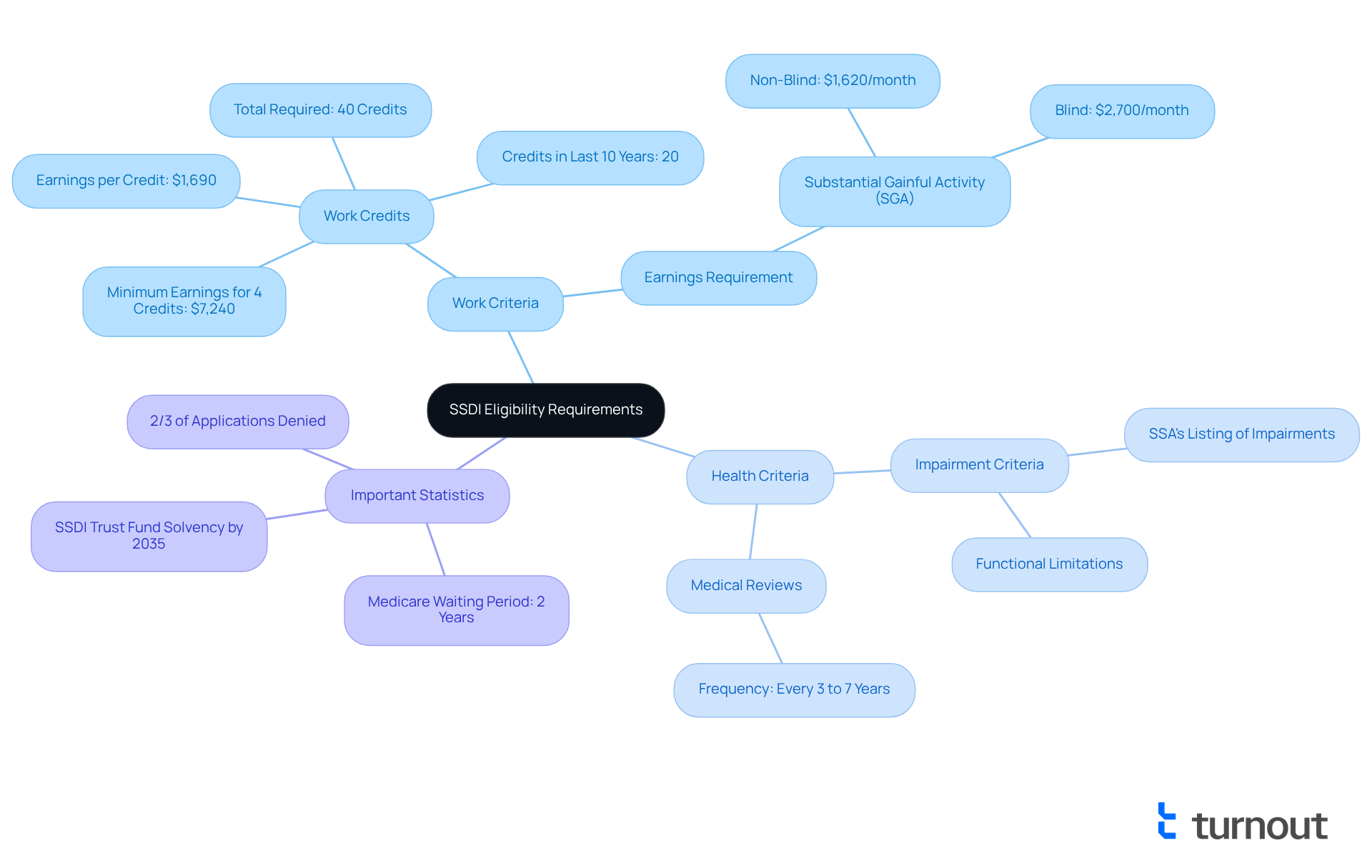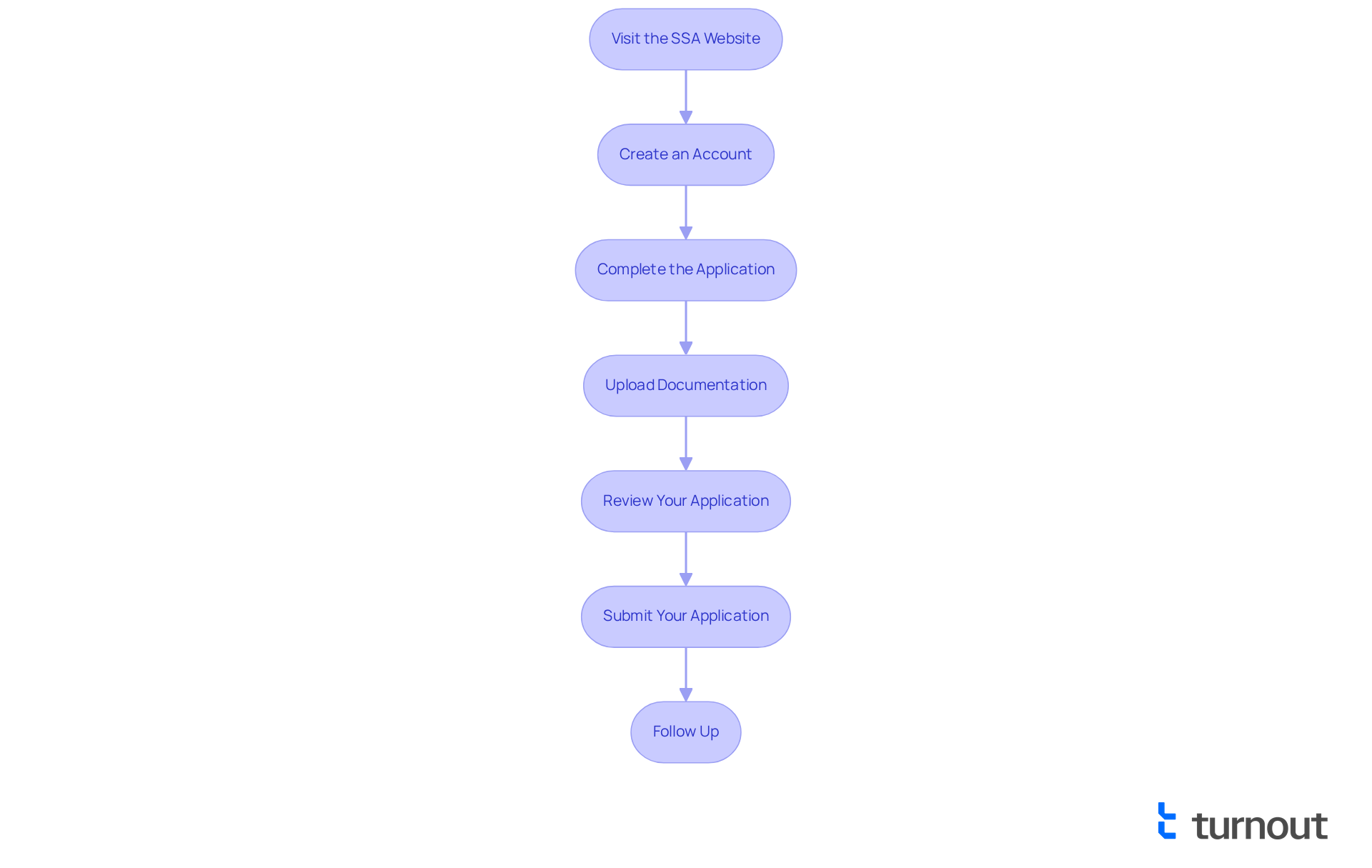Overview
This article serves as a caring guide through the step-by-step application process for Social Security Disability Insurance (SSDI). We understand that navigating this journey can be overwhelming, and it's crucial to grasp the eligibility requirements, gather the necessary documentation, and address common application issues.
By preparing thoroughly and seeking expert assistance, you can significantly enhance your chances of a successful application. Remember, you are not alone in this journey; many face similar challenges. In fact, approximately two-thirds of initial applications are denied due to incomplete information or inadequate documentation.
Take heart in knowing that with the right support and preparation, you can overcome these hurdles. We're here to help you every step of the way.
Introduction
Navigating the Social Security Disability Insurance (SSDI) application process can feel like a daunting journey. We understand that the complexities of eligibility requirements and the potential for initial denials can be overwhelming. This guide offers a step-by-step approach to successfully applying for SSDI benefits, emphasizing the critical documentation needed and the common pitfalls to avoid.
It's common to feel lost when faced with such challenges. But what happens when the application process becomes too much to bear? How can you ensure you don’t fall victim to the high denial rates? Understanding the intricacies of the SSDI application can make all the difference in securing the support you need during these challenging times. Remember, you are not alone in this journey; we're here to help.
Understand SSDI Eligibility Requirements
We understand that navigating the application for SSDI can feel overwhelming. To be eligible, applicants must meet specific work and health criteria. Typically, you need to have been employed in positions covered by Social Security and have a medical condition that aligns with the Social Security Administration's (SSA) strict impairment criteria. As of 2025, you must have accumulated enough work credits—generally 40, with at least 20 earned in the last 10 years. One work credit is earned for every $1,690 in wages or self-employment income, with a maximum of four credits available each year. This means you’ll need at least $7,240 in earnings to qualify.
It's also important to note that your condition must prevent you from engaging in substantial gainful activity (SGA), which is defined as earning more than $1,620 per month for non-blind individuals. Staying informed about these requirements is crucial. We encourage you to visit the SSA's official website or consult with an experienced benefits advocate. Understanding these criteria can significantly enhance your chances of a successful application for SSDI.
Remember, approximately two-thirds of initial applications for SSDI are denied. This statistic underlines the value of seeking expert guidance. Additionally, be mindful that medical reviews for disability claims are typically conducted every 3 to 7 years, and SSD recipients face a two-year waiting period for Medicare eligibility. Lastly, concerns about the SSDI Trust Fund's solvency by 2035 may influence future benefits. You are not alone in this journey, and we’re here to help you through it.

Gather Necessary Documentation for Your Application
Before initiating your SSDI application, it’s crucial to gather the following documents to ensure a smooth process:
-
Personal Information: This includes your Social Security number, birth certificate, and current contact information. Having these readily available is essential for the application for SSDI.
-
Health Records: We understand that gathering health documentation can feel overwhelming. Compile detailed records from your healthcare providers, including your diagnosis, treatment history, and how your condition impacts your ability to work. Thorough health records are essential for your application for SSDI, as they support your assertion and illustrate the extent of your condition. To gather these records, you may need to complete a Medical Release Form (Form SSA-827) to allow the SSA to obtain your medical information directly from your healthcare providers.
-
Employment Records: Collecting pay stubs, W-2 forms, and tax returns is important to verify your work history and earnings. These documents help the SSA assess your eligibility based on your past contributions to the Social Security system.
-
Other Relevant Documents: Include any previous disability claims, award letters, or correspondence with the SSA. Possessing a complete set of documents will simplify your application for SSDI and reduce potential delays.
Gathering these documents can take several weeks, with an average timeframe of 3-5 weeks depending on the complexity of your medical history. Therefore, it’s advisable to start early. Disability advocates emphasize that thorough preparation can significantly improve your chances of a successful application for SSDI submission. As one advocate noted, "The more organized your documentation, the smoother the process will be." By dedicating time to gather these materials, you prepare yourself for a more efficient submission experience. Remember, you are not alone in this journey; we’re here to help.

Complete the Online SSDI Application Step-by-Step
Completing the application for SSDI online can feel overwhelming, but we’re here to guide you through each step with care and understanding. Here’s how to navigate the process effectively:
- Visit the SSA Website: Start by navigating to www.ssa.gov/disability and selecting 'Apply for Benefits.' This is your first step toward completing your application for SSDI to get the support you need.
- Create an Account: If you don’t already have an account, take a moment to establish one. This is essential for beginning your request.
- Complete the application for SSDI: When filling out the application for SSDI, provide your essential personal information, including your Social Security number, contact details, and health history. Remember, this information is crucial.
- Upload Documentation: Attach important documents, such as health records and employment history. These documents are vital for a successful submission.
- Review Your Application: It’s common to feel anxious about mistakes. Carefully check all your information for accuracy before submitting your application for SSDI. Remember, more than half of all initial disability claims are rejected, often due to inadequate medical documentation or incomplete details. Taking your time here can make a difference.
- Submit your application for SSDI: Once everything is complete, submit your application for SSDI. You will receive a confirmation number, which is important to keep for your records.
- Follow Up: After submission, you can easily check the status of your request online or by contacting the SSA. Staying informed can ease your worries.
Before you start, gather all necessary documentation. Thorough preparation can significantly enhance your chances of approval. While the average duration for processing online submissions is around three to five months, the total process may take longer, especially if an appeal is needed. Remember, you are not alone in this journey. Ensuring thoroughness in your request can greatly improve your chances of success, as many candidates face challenges due to incomplete submissions. We believe in your ability to navigate this process.

Troubleshoot Common Application Issues
Navigating the SSDI enrollment process can be challenging, and it's common to encounter issues that may feel overwhelming. We understand that these obstacles can be frustrating, but there are effective troubleshooting tips to help you overcome them.
- Incomplete Information: One of the most frequent pitfalls is incomplete information. Ensure that all required fields are filled out completely. Did you know that approximately 65-70% of initial SSDI requests are denied for this reason? This statistic underscores the importance of thoroughness in your submission.
- Document Upload Errors: If you’re having trouble uploading documents, take a moment to verify that you’re using the correct file formats and sizes. The SSA typically accepts PDF or JPEG formats, so double-check your files before submission to avoid delays.
- Technical Difficulties: It's not uncommon for technical issues to arise. Should the SSA website be down or if you experience any difficulties, don’t hesitate to try again later or switch to a different browser. Remember, persistent technical issues can hinder your progress.
- Request Denial: If your request is denied, it’s important to carefully review the denial letter to understand the reasons behind the decision. Seeking legal representation can significantly increase your chances of success, as represented applicants achieve approval rates 20-30% higher than those without counsel. This highlights the value of seeking assistance when needed.
- Timely Filing: Keep in mind that strict deadlines apply when filing SSD appeals. Missing these deadlines can lead to unnecessary delays or even dismissal of your claim. Staying organized is key.
- Seek Support: If you’re feeling lost in the enrollment process, consider reaching out to a benefits advocate. Their expertise can provide personalized help and guidance, ensuring you avoid common pitfalls and improve your chances of approval. As one advocate noted, "Working with an experienced disability attorney or advocate can help you avoid these pitfalls and significantly improve your chances of approval."
By following these tips and seeking support when needed, you can navigate the application for SSDI process with greater confidence. Remember, you are not alone in this journey, and we’re here to help you secure the benefits you deserve.

Conclusion
Navigating the SSDI application process can feel overwhelming, but understanding the steps involved can significantly increase your chances of achieving a successful outcome. This guide has laid out the essential eligibility criteria, the documentation you will need, and the step-by-step process for completing the online application. By familiarizing yourself with these components, you can approach your SSDI journey with greater confidence and clarity.
Key insights from this article emphasize the importance of thorough preparation and the necessity of gathering comprehensive documentation. From personal and health records to employment history, each piece of information plays a vital role in supporting your application. It’s common to feel anxious about potential pitfalls, such as incomplete submissions and technical issues, but recognizing these can help you avoid setbacks that lead to denials. Seeking expert assistance, whether through a benefits advocate or legal representation, can further bolster your chances of approval.
Ultimately, the SSDI application process is not just about meeting criteria; it’s about advocating for yourself and ensuring that all necessary steps are taken to secure the benefits you deserve. By being proactive, organized, and informed, you can navigate this complex system more effectively. The journey may be challenging, but remember: with the right tools and support, success is within your reach. You are not alone in this journey, and we’re here to help you every step of the way.
Frequently Asked Questions
What are the eligibility requirements for SSDI?
To be eligible for SSDI, applicants must have been employed in positions covered by Social Security and have a medical condition that meets the SSA's impairment criteria. As of 2025, you need to have accumulated at least 40 work credits, with at least 20 earned in the last 10 years.
How are work credits earned for SSDI?
Work credits are earned based on income; one credit is earned for every $1,690 in wages or self-employment income, with a maximum of four credits available per year. Therefore, you need at least $7,240 in earnings to qualify.
What is substantial gainful activity (SGA)?
Substantial gainful activity (SGA) is defined as earning more than $1,620 per month for non-blind individuals. Your medical condition must prevent you from engaging in SGA to qualify for SSDI.
What percentage of initial SSDI applications are denied?
Approximately two-thirds of initial applications for SSDI are denied, highlighting the importance of understanding eligibility requirements and seeking expert guidance.
How often are medical reviews conducted for SSDI claims?
Medical reviews for disability claims are typically conducted every 3 to 7 years for SSDI recipients.
Is there a waiting period for Medicare eligibility after receiving SSDI?
Yes, SSDI recipients face a two-year waiting period for Medicare eligibility.
What concerns exist regarding the SSDI Trust Fund?
There are concerns about the SSDI Trust Fund's solvency by 2035, which may influence future benefits.




